HOSTED JOINTLY BY THE CONGRESSIONAL HUMAN RIGHTS CAUCUS AND THE CONGRESSIONAL BLACK CAUCUS HEALTH BRAIN TRUST TESTIMONY OF A FORMER FIELD DOCTOR FOR MSF
Transcript of an MSF doctor's extemporaneous remarks on Kala Azar in the Sudan before the Congressional Human Rights Caucus and the Congressional Black Caucus Health Brain Trust on access to medicines.This is a transcript of Dr. Jill Seaman's extemporaneous remarks on May 15
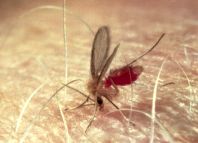
Slide 1 - Sand Fly. Photo ©Copyright Edgar Rowton/Walter Reade |
In 1989, MSF dropped me off in the middle of war-torn south Sudan, and soon I realized I was in an area where more than 50% of the population had already died-and they had died of Kala Azar. That's an amazing thing, when you imagine 50% of a suburb of Washington DC dying; it would certainly get the attention of a lot of people. So I was, of course, a bit shocked and wondered what to do. It's a parasitic disease. It causes fever, wasting, and ultimately death in virtually everyone who gets the disease. But that doesn't do justice to what it does to you. The people that I saw walking, adults taller than I am, weighed 60-90 pounds had about a quarter of my blood supply and had fevers to 104. These people are incredibly, incredibly sick and... this is the insect responsible [indicates slide 1].
This is a sand fly-this is a Walter Reade picture, I couldn't possibly do it-this is a sand fly. It's smaller than a mosquito, which means that it gets through a mosquito net making vector control very difficult. And this is the cause of these epidemics that can kill up to 50% or even more of a population. And if that happens, obviously there's an access problem-an access to treatment problem. And I must say as a qualifier that the access problem isn't limited just to drugs, of course being in a war zone does make a problem. This is our clinic the morning after a midnight attack [indicates slide 2]. And that certainly is an issue, but it wasn't the biggest issue. them medicine. And that's where this discussion leads to, of course.
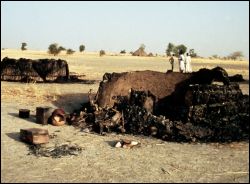
Slide 2 - Clinic after an attack. Photo ©Copyright MSF |
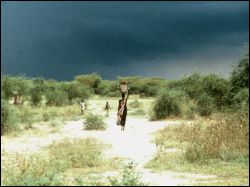
Slide 3 - Darkening sky. Photo ©Copyright MSF |
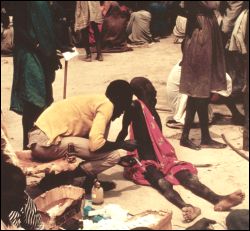
Slide 4 - Giving IV injection. Photo ©Copyright MSF |
There were infrastructure problems, perhaps-this is the infrastructure of south Sudan; this is the highway [indicates slide 3].
And it works very well by the way. People could access care, they had to walk perhaps two days to two weeks, but that was not the issue. They are quite willing to walk on these beautiful highways. And they would arrive maybe in the hands of their sister, because their mother had died on the path. But they were desperate for treatment-they were really, really wanting to have treatment and our treatment center was known as the place of hope, because now maybe some treatment had come to the area. And it wasn't the infrastructure that had been the problem-if you need hospital housing, just buy a sickle and people will cut grass and get you hospital housing. And it wasn't the education, either. Because we took people who had never had the luxury of even a primary school education, and we were able to get people trained to give
The medicine is injections of pentavalent antimony - sodium stibogluconate is the name of the drug. And let me tell you, I have a love/hate relationship with this drug, because you can imagine seeing every evening hundreds of virtually stick people walking to your clinic everyday. You see them coming and you know they're tomorrow's patients, but you also know you have a drug to treat them with. And that was absolutely lovely. But it isn't completely lovely. This man here [indicates slide 4], he's going to give 100 injections a day. The injections actually hurt, and it takes 30 days worth of these injections to get better. When you first get the injections, the first week, you actually feel worse than you did when you came-you really don't feel good. About a week after you finish the injections, your energy comes back as does your appetite. And so those people do so well a week after they finish their treatment. This drug was first introduced as a drug in the 1900s, as a drug to make you vomit. And in the 1940s someone changed it a bit and it became a drug that could treat Kala Azar. And by the way, it still makes you vomit. In 1940, this was a great advance. But now we're injecting heavy metals into people-we drink filtered water, so we don't have heavy metals-and we're injecting them. And we sort of think that in the 21st century, maybe we could do a little bit better. And some of the reason is because maybe 10% of the people die during treatment. You know, you go to sleep at night, and you wake up thinking, "please don't let anybody die today". And you admit people, and you think, "well if I admit 150 people today, 15 of those people are going to die. Is it that little girl in her sister's arms? Or is it the boy that looks at you with hope in his eyes and fear?" You see the patients-they're real-and you know they're going to die, and you think "is there something wrong? Maybe there's something else out there." And that's of course what you hope; you think there must be something more.
And there's a little bit of good news, because it turned out by accident there was something more. Some doctors in the US discovered liposomal Amphotericin B called AmBisome, and they gave us a donation to try. And let me tell you, it's a miracle drug. This drug is IV, and let me tell you, you can do IVs in south Sudan. The tree is a very good IV stand, you do not need to build a hospital.
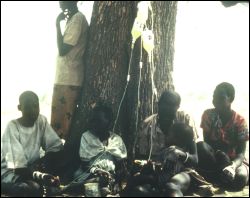
Slide 5 - IVs hanging from the trees. Photo ©Copyright MSF |
And our patients were miraculously cured. This is a drug where after six days; the child that you thought was dead comes onto your compound with her stick and smiles and says, "good morning, how are you?" It's miraculous. But the problem, of course, is that it comes at a miraculous price. And this price is-I know you can't see it [indicates slide 5], but it lists the drugs that we have for Kala Azar, not one of them was developed for Kala Azar in the last 60 years. One drug is this SSG I've been talking about, sodium stibogluconate. It sells for about $28 per treatment for a 50-kilo person. Most of our patients don't weigh that much, but that's still quite a bit of money. 60-80% of people in India are resistant, so it's no longer of use. The next one is paromomycin, a lovely antibiotic-off the market, because there's no market for it. Nobody with money has a disease that needs to have this for treatment. And then there's AmBisome. And the price we get, or we could get for AmBisome is 1,800 US dollars per person treated-obviously not possible. And that's just peanuts compared to what you'd pay for it here in the US, by the way-they are giving us a good deal. But I think this sort of explains the problem… that we don't have a drug that we would love-we would really love to be able to see the patients who are willing to walk two weeks to see us and say, " I've got a lovely cure for you. You won't get sicker with this drug". And that's what, of course, we're hoping for. And the… of course, outcome of treatment is what we really want-people healthy, back at home, happy and self-sufficient, as in this young lady [indicates slide 6].
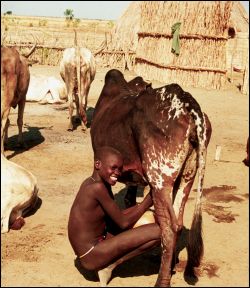
Slide 2 - Boy milking cow. Photo ©Copyright MSF |
I would like to end by saying that I'm an American doctor, and the excellence in medicine in America is absolutely phenomenal. The capabilities and the capacity of the R&D labs in this country is also phenomenal. And somehow I think there needs to be some equity and distribution of these life saving health care options, especially in terms of research & development of drugs to treat these diseases of people who are so poor they are not of market value. They are of human value. Thank you.



